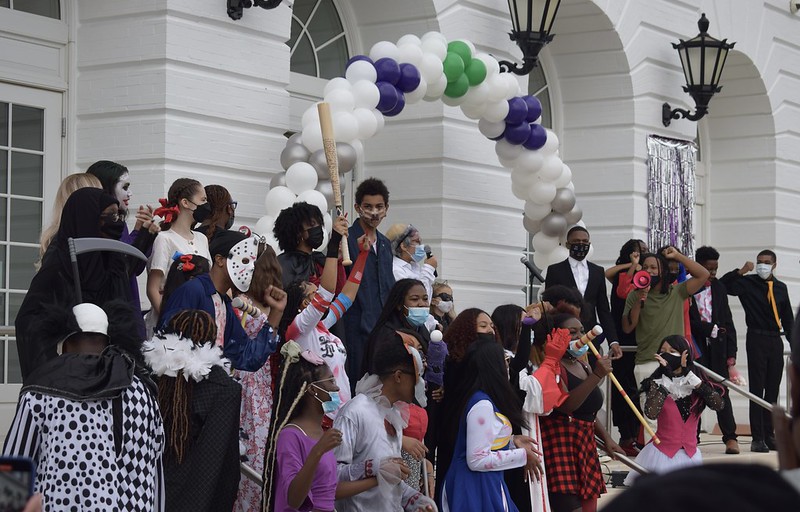The front lawn of the Duke Ellington School of the Arts was alive with motion. The ground was littered with hula hoops, streamers, and hyperactive toddlers. A red-and-white bounce house sat next to a snow cone truck parked alongside the fence. Half a dozen balloon arches loomed over vendors selling Sour Patch Kids, hand-woven baskets, and local author Laura Morgan Roberts’s poetry and photography book Almost Free. But the real show hadn’t yet begun.
On Oct. 21, Duke Ellington hosted its eighth annual March for the Arts, an event meant to fund its students’ work in the arts. Ellington’s goal of $75,000 would go towards hiring instructors, funding classes, and making sets and costumes. Food trucks and lawn games notwithstanding, most guests came for the main attraction.
The cornerstone of March for the Arts is an hour-long, walking tour-style play put on by over 40 Ellington students. The production featured outrageous costumes, intricate dance numbers, and artistic performances peppered throughout.
The story of the play itself follows a group in the Artist’s Magical Dream World, an imaginary space where all the world’s greatest artists—including celebrities like Judy Garland, Michael Jackson, and Marilyn Monroe—live and create together. But crisis strikes when their creativity starts fading, forcing the artists to journey into the “real world” of Georgetown and discover “why people don’t like art.”
The production, a partial spoof of Barbie (2023), balances the zany and outrageous with the earnest and profound. A duet performed by William Shakespeare and Langston Hughes manages to both be ridiculous and speak to the universality of the written word; an impromptu freestyle rap session feels strange in historic Georgetown, but implicitly rejects the barriers that relegate art to certain spaces. These are the ideals the Duke Ellington School was founded on.
Duke Ellington School of the Arts was established in 1974 by two Black artists, Peggy Cooper-Cafritz and Mike Malone, to ensure that young people could receive an arts education, regardless of their socioeconomic status. This commitment to financial inclusion fosters an incredibly diverse student body—according to U.S. News and World Report, Ellington’s student population is 67 percent Black and 84 percent students of color overall.
“Art teaches inclusion,” Ellington teacher and director of March for the Arts Dawn Naser said. “We can recognize through our art that we’re all different—that we learn differently, that we think differently, that we feel differently—and there’s still a space for all of us. We need all different gifts to create something meaningful.”
March for the Arts is a collaboration between teachers and students. “[Students] are very much involved in carrying out the event,” said Naser. “There’s a marketing team, a stage management team, a group responsible for the decorations and creating the whole look of the event. Even though there are faculty involved, the students are very much part of planning and implementing the event.”
The March for the Arts website also draws in guests, inviting them to dress as their “most eccentric and creative self,” further uplifting the value of free expression. The characters themselves are burlesque versions of their real-life counterparts. Michael Jackson’s soft-spoken hemming and hawing and wacky drew plenty of laughs from the crowd, as did the necessity for an “Oprah Winfrey translator.” This was reflected in the costumes, too; Marilyn Monroe, regal in her iconic white dress, stood next to Judy Garland and her red ruby slippers.
The normal people were even more caricatured. The artists’ guides through Georgetown, Rob and Bob, were dismissed by other characters for the entirety of the narrative. The men, both accountants, bragged about their time as mathletes and wore brown suits. Bob idolizes his “Ink Jet blue” pen and Rob uses the word “savage” constantly and unironically. These characters, the play seems to imply, demonstrate what the world would look like without art—colorless, dreamless, aimless.
Similar themes underpin the interactions between other “real people” and the band of artists. In one scene, the artists stumble upon an outdoor HR training, at first mistaking it for “an awesome dance circle.” After one of the businesspeople explains, the artists gasp in unison. “I can’t imagine anything more horrible,” a mortified Queen Latifah says.
In another scene, a tyrannical teacher chews out a young student for not bringing her textbook to recess. The artists, already confused by the lack of “rainsticks,” “yoga mats” and “character exploration”—all hallmarks of art schools—are horrified to see creativity devalued in education.
Similarly, the artists’ run-in with a corrupt politician who doesn’t value art satirizes the District’s 2010 attempt to move Ellington out of Georgetown. These non-artists are situated as the antagonists of this story and reveal the problems that Ellington’s young artists see in their community, Naser said. In a world without art, we are left with an education system that stifles creativity and a business world that saps joy.
Despite these looming challenges, the characters remain optimistic; the solution is clear. At the end of the production, the entire audience is gathered around the 40-some artists on the Duke Ellington lawn. Queen Latifah turns to Rob and Bob. “You both are a very special part of the artistic community. You see value in art. You support us by supporting our shows, seeing our work in galleries, lobbying for the arts in Washington, performing in community theatre or”—with a coy wink to the audience—”donating to March for the Arts!”
The production makes a case for the arts, and the institutions that nurture them, by pointing out that an artist lives in each of us. By making the entirety of Georgetown their stage, Ellington students invite all its residents to take part in their masterpiece.
At one point in the production, the artists abruptly stopped walking. Rhythmic, bass-heavy music began leaking from the speaker, and the artists began to chant.
“Keep the arts alive. Keep the arts alive.”
After a moment, a little girl began to chant with them from her mother’s shoulders. One by one, more people joined, until the entire audience thundered with one voice.
“Keep the arts alive. Keep the arts alive.”





